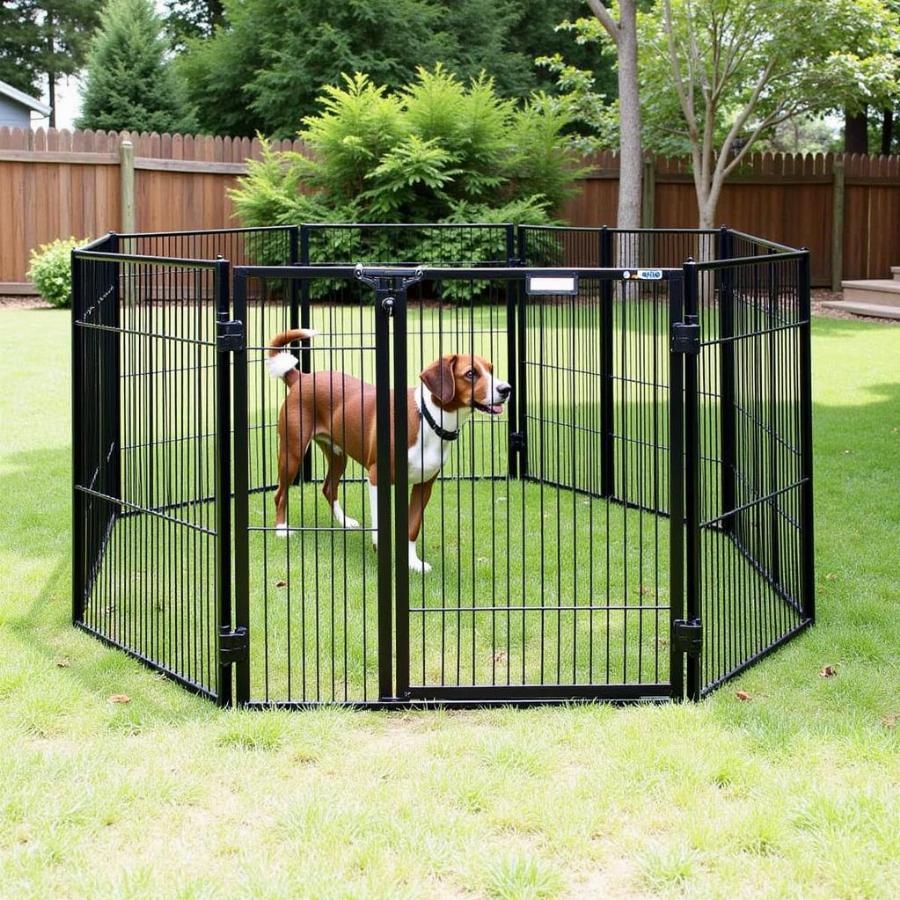Dog door gates are essential tools for pet owners, providing a safe and convenient way to manage your dog’s movement within your home and yard. Whether you’re potty training a puppy, keeping your dog out of certain rooms, or creating a safe outdoor space, dog door gates offer a versatile solution. But with so many options available, choosing the right gate can feel overwhelming. This guide will help you navigate the world of dog door gates, covering everything from choosing the right size and material to installation and safety tips.
Understanding Your Needs and Choosing the Right Type of Dog Door Gate
Before diving into the specifics, it’s crucial to assess your individual needs. What’s the primary purpose of the gate? Is it for indoor or outdoor use? What size and breed is your dog? These factors will greatly influence your decision.
What are the different types of dog door gates?
There are various types of dog door gates, each designed for specific needs:
- Pressure-mounted gates: These are ideal for doorways and hallways, relying on pressure against the walls for stability. They’re easy to install and remove, making them a popular choice for temporary use. However, they’re not recommended for top of stairs due to safety concerns.
- Hardware-mounted gates: Offering maximum security, these gates are screwed into the wall or door frame. They are suitable for top of stairs and areas where extra security is needed, providing a more permanent solution.
- Freestanding gates: These portable gates are useful for creating temporary barriers anywhere in your home or yard. They’re often foldable and easy to store, offering flexibility for various situations.
- Extra tall and wide gates: Designed for larger breeds or particularly agile dogs, these gates offer increased height and width to prevent jumping or squeezing through.
Considering Your Dog’s Size and Breed
Your dog’s size and breed play a pivotal role in selecting the right gate. For smaller breeds, a standard height gate might suffice. However, for larger or more athletic dogs, you’ll need a taller gate to prevent jumping. Consider your dog’s jumping ability and choose a height that discourages this behavior.
How do I measure my dog for a dog door gate?
Measure your dog’s height from the ground to the top of their shoulders. Add a few inches to this measurement to determine the minimum height of the gate you need. Also, consider your dog’s width, especially if they tend to squeeze through narrow spaces.
Materials and Durability
Dog door gates are made from various materials, including metal, wood, and plastic. Metal gates are generally the most durable, while wooden gates offer a more aesthetically pleasing option. Plastic gates are lightweight and affordable but might not be as sturdy as metal or wood.
What is the most durable material for a dog door gate?
Metal, especially steel, is typically the most durable material for dog door gates. It can withstand wear and tear from chewing and scratching, making it a good choice for active dogs.
Installation and Safety
Proper installation is crucial for ensuring the gate’s effectiveness and safety. Follow the manufacturer’s instructions carefully, ensuring a secure fit. For pressure-mounted gates, ensure adequate pressure to prevent the gate from collapsing. For hardware-mounted gates, use appropriate screws and anchors for a secure installation.
How do I install a pressure-mounted dog door gate?
Pressure-mounted gates are generally easy to install. Extend the gate to fit the opening, ensuring it’s snugly in place. Tighten the pressure knobs or levers until the gate is secure and doesn’t move easily.
 Freestanding Dog Gate Used in a Yard
Freestanding Dog Gate Used in a Yard
Indoor vs. Outdoor Dog Gates
Consider where you plan to use the gate. Dog gates for indoors are typically designed for interior use and may not be weather-resistant. Outdoor dog gates for decks and other outdoor areas are made from weather-resistant materials to withstand the elements.
What type of gate is best for outdoor use?
For outdoor use, choose a gate made from weather-resistant materials like metal or treated wood. Ensure it’s sturdy enough to withstand wind and other weather conditions. Consider outdoor dog gates and fences for larger areas.
Maintaining Your Dog Door Gate
Regular cleaning and maintenance will extend the life of your dog door gate. Wipe down the gate with a damp cloth to remove dirt and debris. Check for loose screws or parts and tighten or replace them as needed.
Conclusion
Choosing the right dog door gates is essential for creating a safe and manageable environment for your furry friend. By considering your dog’s size, breed, and your specific needs, you can choose a gate that provides security, convenience, and peace of mind. Door gates for dogs are a valuable investment for any dog owner.
FAQs
-
Are dog door gates safe for puppies? Yes, dog door gates are an excellent tool for managing puppies, especially during potty training.
-
Can I use a dog door gate at the top of the stairs? Hardware-mounted gates are recommended for the top of stairs, while pressure-mounted gates are not.
-
How tall should a dog door gate be? The height of the gate should be several inches taller than your dog’s height at the shoulders.
-
What is the best material for a dog door gate? Metal is typically the most durable material.
-
Are freestanding gates safe? Freestanding gates are safe for temporary use but may not be as secure as pressure-mounted or hardware-mounted gates. Large dog gates indoor might require hardware mounting for additional security.
Beaut Dogs is your trusted source for all things dog-related. We provide expert advice and resources to help you navigate the joys and challenges of dog ownership. For personalized support and answers to your specific questions, please contact us via Email: [email protected]. Beaut Dogs is committed to helping you provide the best possible care for your beloved canine companion. Visit us at https://beautdogs.com to learn more.